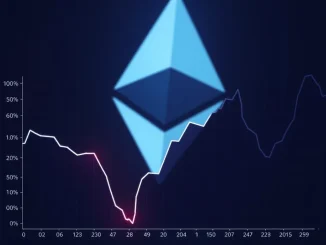
For anyone tracking the dynamic world of digital assets, keeping an eye on key global economic signals is a must. One of the most watched is the **US CPI data**, and the latest release for April offers some interesting insights that could ripple through the **crypto market**.
Understanding the Latest US CPI Data
The U.S. Bureau of Labor Statistics recently released its Consumer Price Index report for April, providing a snapshot of the current **inflation rate**. Here’s what the data showed:
- Overall CPI (Year-over-Year): Rose 2.3%, slightly under the 2.4% forecast.
- Overall CPI (Month-over-Month): Increased 0.2%, also a bit below the 0.3% expectation.
- Core CPI (Excluding Food & Energy, Year-over-Year): Climbed 2.8%, matching the 2.8% prediction.
- Core CPI (Excluding Food & Energy, Month-over-Month): Went up 0.2%, just under the expected 0.3%.
These numbers are significant because CPI is a primary measure of inflation, tracking the average change over time in the prices paid by urban consumers for a basket of consumer goods and services.
Why These Economic Indicators Matter for the Crypto Market
You might wonder why statistics about consumer prices in the U.S. are relevant to Bitcoin, Ethereum, or other cryptocurrencies. The connection lies in monetary policy and investor sentiment.
Central banks, particularly the U.S. Federal Reserve, closely monitor **economic indicators** like the CPI to make decisions about **interest rates**. When inflation is high and rising, the Fed is more likely to raise interest rates to cool down the economy. Conversely, if inflation appears to be easing, the pressure to raise rates lessens, and they might even consider rate cuts.
The Link Between Interest Rates and the Crypto Market
Higher **interest rates** generally make traditional, lower-risk investments like bonds more attractive. This can sometimes lead investors to pull money out of riskier assets, including stocks and cryptocurrencies. Lower interest rates, on the other hand, can make risk assets more appealing as the potential returns outweigh the lower yield from safer options.
The April **US CPI data** showing a slightly lower-than-expected **inflation rate** could be interpreted by markets as a sign that inflationary pressures are moderating. While the core CPI remained stable year-over-year, the slight misses on the overall and monthly figures suggest a potential easing trend.
Potential Impact on the Crypto Market Reaction
A sustained trend of moderating inflation could influence the Federal Reserve’s timeline for potential interest rate adjustments. If the Fed becomes less inclined to raise rates further, or if expectations for future rate cuts increase, this environment is generally viewed positively for growth and risk assets like those in the **crypto market**. While no single data point dictates market movement, the CPI report is a crucial piece of the puzzle investors use to gauge the economic outlook.
Summary: Navigating Economic Signals
The April **US CPI data**, showing a slightly softer **inflation rate** than anticipated, serves as a key piece of the economic landscape. As one of the most watched **economic indicators**, it provides insight into the potential direction of **interest rates**, which in turn can influence the appetite for risk assets. For participants in the **crypto market**, understanding these macroeconomic signals is vital for navigating the potential shifts and trends ahead. Keep watching for how future data releases continue to shape the economic narrative and its impact on digital assets.



